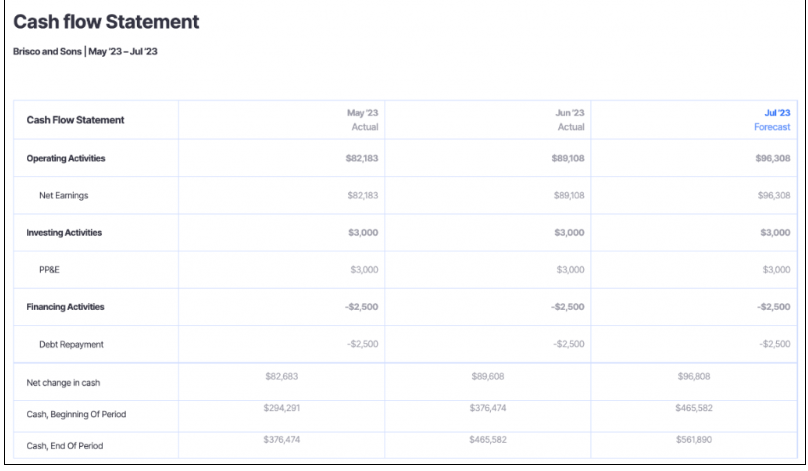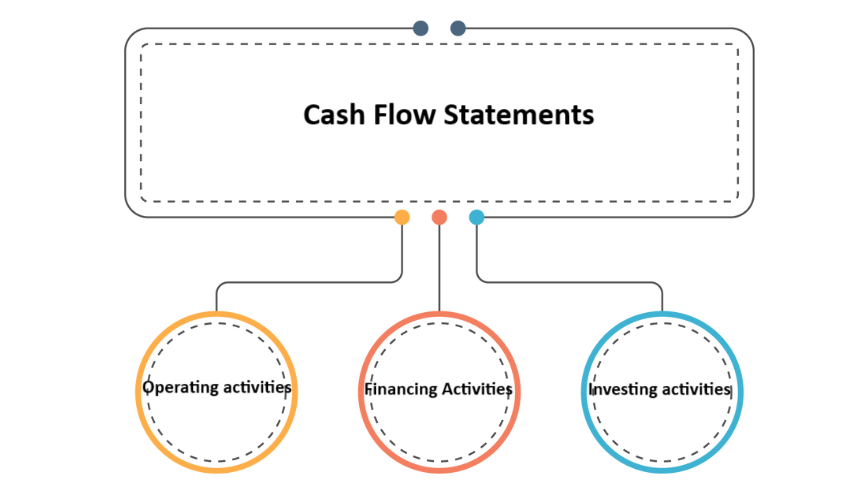Cash Flow Statements are used to track the inflow and outflow of cash in a working company. This is a very important criterion for calculating the financial health and efficiency of processes in a company.
The cash flow statements are used to measure how well it manages its cash operations while maintaining the efficiency and productivity of the company. In this article, we will learn how to read cash flow statements and its importance.
What are Cash Flow Statements?
A Cash flow statement is used to track the amount of cash entering and leaving the company. A Company’s financial health is highlighted by measuring how easily it generates cash.
If you need to calculate cash flow statements, start analysing the outflow and inflow of cash in each category i,e.operating activities, investing activities, and financing activities.
Cash Flow Statements Key Takeaways
- A cash flow statement is used to track the company’s overall intake and outtake of cash.
- Cash Flow Statements determine the ability of a company to generate cash to fund operation activities, pay debts, and invest in growth.
- There are three major components of cash flow statements are operating activities, investing activities, and financing activities.
Understanding Cash Flow Statements
As a small business or startup, your first priority is maintaining a smooth supply of cash. Cash flow is one of the most important indicators of the financial stability of a company.

A general cash flow statement is divided into three major categories i,e. Operating activities, investing activities, and financing activities.

- Operating activities: This category depicts the transaction flow in a company’s day to day operations.
- Investing Activities: This component of cash flow statements is used to analyse the cash flow in investing activities like buying long-term assets or selling securities in the share market.
- Financing Activities: Financing includes cash flow expenses from loans, raising funds, and distributing funds, to support the company’s operations and expansion.
How to Read Cash Flow Statements?
A Cash Flow Statement provides crucial information from investment, finance, and operation activities. Let us understand some of the important things while reading a cash flow statement.
1. Know the structure
Before starting with the cash flow statements, you must be familiar with the arrangement of cash flow statements that is arranged in three major categories.
- Operating activities
- Investing activities
- Financing Activities
Also, check Stock Market Investing
2. Operating activities
This section briefly analyses the day to day core business operations within the organisation. For example, cash receipts from customers, cash paid to suppliers, non cash items, etc.
A positive cash flow indicates the company is managing its operations efficiently which is a good sign of financial health. A negative cash flow is an indication of the growth state of a company when the company is struggling to generate sufficient revenue and hence cash flow.
3. Investing Activities
This section includes the outflow and inflow of investment expenditure on securities, mutual funds, bonds, long long-term assets. Cash flow generated for purchasing of capital assets, sale of assets, or securities.
4. Financial Activities
Analyze the cash inflows and outflows generated from borrowing, debt repayments, paying dividends, issuing equities, stocks, initiating loans, etc. A company must not over depend on external sources for financing.
A positive cash flow in this category means the company is raising funds through loans or equities, which could depict expansion or financial stress.
5. Net Increase/Decrease in Cash Flow
A company analyses its increase or decrease in cash flow from all three categories i,e. Investing, financing, and operating. In Cash flow statements, opening cash balance and closing cash balance are given at the bottom for a specific time period.
This balance represents cash and bank balances at the end of an accounting period. It is represented in cash flow statements at the end of the previous accounting period. You can check month over month or year-over-year changes in the cash flow of your company. Analyze the major factors behind the shift.
6. Analyse Trends
You can track the cash flow trends of a company over a specific period of time to know whether a company generates positive cash flow from its operations, investing, and financial activities.
A company with strong positive cash flow, financing, and investing cash flows indicates stability and potential for future growth.
7. Cash Flow Ratios
Cash flow ratios represent a ratio between cash flows and expenditure, sales, or debt. It represents the company’s ability to cover short-term obligations using only cash equivalents or cash.
The cash ratio is equal to cash equivalents or cash to current liabilities for the company. A cash ratio equal to one or greater represents the same amount of current liabilities as it uses cash or equivalents to pay off its debts.
Common Terms used in Cash Flow Statements
While reading a cash flow statement you must be aware about some of the common terms of cash flow statements.
-
- Net Income: The profit obtained after reading all expenses and taxes incurred over a period.
- Depreciation: It is an accounting measure that acknowledges the life of an asset after taking into account its wear and tear over time.
- Changes in the working capital: It might indicate changes in accounts receivable, inventory, accounts payable, salaries payable, etc.
- Dividends paid: Cash outflows made to the shareholders from a part of the revenue generated over a period.
- Amortization: It is similar to depreciation but applied to intangible assets like trademarks or patents.
- Accounts payable: It is the amount of money a company owes to the suppliers or vendors for goods and services they receive.
- Accounts Receivable: This is the amount of money owed to a company by the customers for the products or services they deliver to them.
- Capital Expenditure: This represents the money spent by a company to acquire and maintain physical assets such as property, infrastructure, equipment, etc. It falls under the cash outflows in the investing activities category.
Also check, What is Financial Performance and How to Calculate?
How to Calculate Cash Flows in Cash Flow Statements?
Cash flow or Net Cash flow is the difference between the overall cash inflows of a company to the overall cash outflows of a company. It is a very important indicator of the financial health of a company.
Net Cash Flow = Total Cash Inflows – Total Cash Outflows
It is very important to maintain a balance between the overall inflows and outflows of cash and equivalents in business operations to maintain a stable and healthy business.
Cash Flow Statements Example
Let us suppose an XYZ company cash flow statement is organised into operating, investing, and financing activities. The company name is XYZ and its cash flow statements for the year ended December 31, 2023
Cash Flows from Operating Activities:
- Net Income: $200,000
- Adjustments to reconcile net income to net cash provided by operating activities:
- Depreciation: $25,000
- Increase in Accounts Receivable: ($15,000)
- Increase in Inventory: ($10,000)
- Increase in Accounts Payable: $12,000
- Increase in Salaries Payable: $5,000
- Amortization of Intangible Assets: $3,000
- Net Cash Provided by Operating Activities: $220,000
Cash Flows from Investing Activities:
- Purchase of Equipment: ($70,000)
- Proceeds from Sale of Investments: $20,000
- Purchase of Property: ($30,000)
- Net Cash Used in Investing Activities: ($80,000)
Cash Flows from Financing Activities:
- Dividends Paid: ($40,000)
- Issuance of Common Stock: $35,000
- Repayment of Long-term Debt: ($25,000)
- Proceeds from Short-term Loans: $10,000
- Net Cash Used in Financing Activities: ($20,000)
Net Increase in Cash and Cash Equivalents: $120,000
- Cash and Cash Equivalents at the Beginning of Year: $80,000
- Cash and Cash Equivalents at the End of the Year: $200,000
Learn Financing and Taxation with PW Skills
If you are looking for a career in finance then elevate your knowledge with the PW Skills Certificate of Taxation Course. This intensive 4-month course is developed in partnership with PwC India. The course is specially prepared to keep in mind to expand careers in the finance sector.
Get industry driven curriculum, real world case studies, tools (excel and Zoho), soft skills, expert instructors, and more only at pwskills.com
Cash Flow Statements FAQs
Q1. What are Cash Flow Statements?
Ans: Cash flow statements are used to track the inflow and outflow of cash in businesses. A good cash position indicates the stability and operational efficiency of a company.
Q2. What are the three components of cash flow statements?
Ans: Cash Flow Statements have three major components, which include operating, investment, and financial activities.
Q3. How to calculate cash flow?
Ans: The formula for net cash flow is the difference of total cash inflows and total cash outflows.
Q4. What is the benefit of Cash Flow statements?
Ans: Cash Flow statements are used to present the cash position of a company which helps in evaluating the financial stability and operational efficiency of a business. It also helps to verify the liquidity position of a company.

